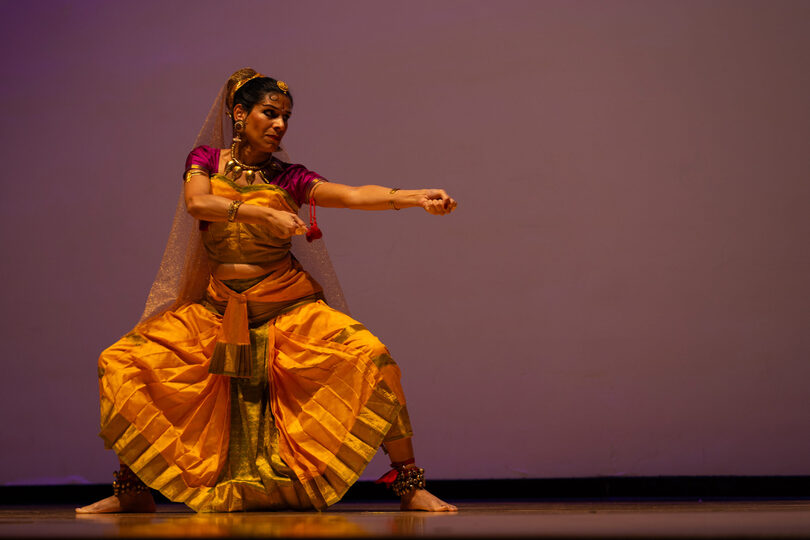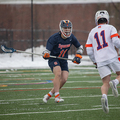Everson dance show ‘brings life’ to Indian art scene at Syracuse

Surya Vaidy | Staff Photographer
The Everson Museum of Art hosted “Shilpanatanam: An Evening of Indian Classical Dance” Tuesday. The performance included four back-to-back performances choreographed by Maya Kulkarni.
Get the latest Syracuse news delivered right to your inbox.
Subscribe to our newsletter here.
As the audience rose to their feet, classical Indian dancers Mesma Belsare and Kaustavi Sarkar embraced, soon joined by their mentor and choreographer Maya Kulkarni. With tears in their eyes, the trio commemorated a night of classical Indian dance with a twist, entitled “Shilpanatanam.”
“I told them that ‘Look, I can teach you all the traditional stuff, but I don’t find it inspiring. So I want to do something different if you’re willing to work with me,’” Kulkarni said. “They were more than willing and they never looked back since then.”
The Everson Museum of Art hosted “Shilpanatanam: An Evening of Indian Classical Dance” Tuesday. The performance consisted of four back-to-back performances of Bharatanatyam (a South Indian classical dance form) by Belsare and Sarker, mixing well-known traditional stories along with Kulkarni’s own creations. The event was organized by two Syracuse University faculty members: Sudha Raj, Director of the Graduate Program in the Department of Nutrition and Food Studies, and Romita Ray, Director of Undergraduate Studies in Art History.
Raj, a dancer herself, wanted to bring this event to SU to emphasize the importance of different cultures at the university and allow students to look into another culture through their respective art.
“It widens that horizon. Many people may not be aware of the cultural art forms,” Raj said. “So for example, when you think about Indian dance, salvation dance, many people think of Bhangra. They think of Bollywood because those are the more publicized media versions of the dance.”
These specific collections of dance were meant to replicate and play with other Indian art forms, such as paintings or sculptures, Raj said. The performance aimed to bring these art forms to life.
There were no dancers in my family, but a very deep love for music and literature and poetry and other things, especially music. It’s nurtured a sense about a holistic approach to dance, not (just) dance, but to arts.Maya Kulkarni, dancer.
Before each performance, Kulkarni provided context to the upcoming dance by telling the story herself through hand gestures and body movements. The first performance, danced by Sarkar, was a four-part rendition of a famous poem by Indian poet Kalidasa called “Rati Vilap.”
Sarkar, traditionally an Odissi dancer and professor, played every role in the dance, depicting everything from demons to devas (Hindu gods). She views these performances as both spiritual and scholarly.
“I really enjoy a journey in general,” Sarkar said. “To remain invested and interested in not just the performing components, but others performing it and theorizing about it.”
Two of the four dances were Kulkarni’s ideas. “Impossible Romance” is about the love story between a cloud and a lightning bolt, and their matchmaker, a peacock. The fable is inspired by another poem by Kalidasa, called “Meghadūta” (The Cloud Messenger).
Kulkarni started dancing at 7 and had a long career in other fields like diplomacy and academia before becoming a full-time dancer. Today, she’s better known as “the dancer’s dancer,” a well-known traditional dance guru, specifically with the Bharatanatyam dance genre.
“There were no dancers in my family, but a very deep love for music and literature and poetry and other things, especially music. It’s nurtured a sense about a holistic approach to dance, not (just) dance, but to arts.” Kulkarni said.
To close the performance, Belsare performed the premiere performance, designed for Syracuse and entitled “Jatayu.” The piece was based on the Ramayana, an ancient sacred text about the story of Rama, an incarnation of the god Vishnu. “Jatayu” was Kulkarni’s rendition of the backstory of Garuda, the bird king, from the Hindu mythology.
“Shilpanatanam” put a spotlight on storytelling by employing new interpretations on classical styles. The performance combined the mental and physical aspects of dance, showcasing a complete storyline for those in attendance.
“I see dance as an activity. Not just a physical activity, but I also see it as a mental activity and something that is very spiritual, so it’s more holistic,” Raj said. “It’s my holistic way of looking at dance as a composite of physical wellness, mental wellness and spiritual wellness.”





